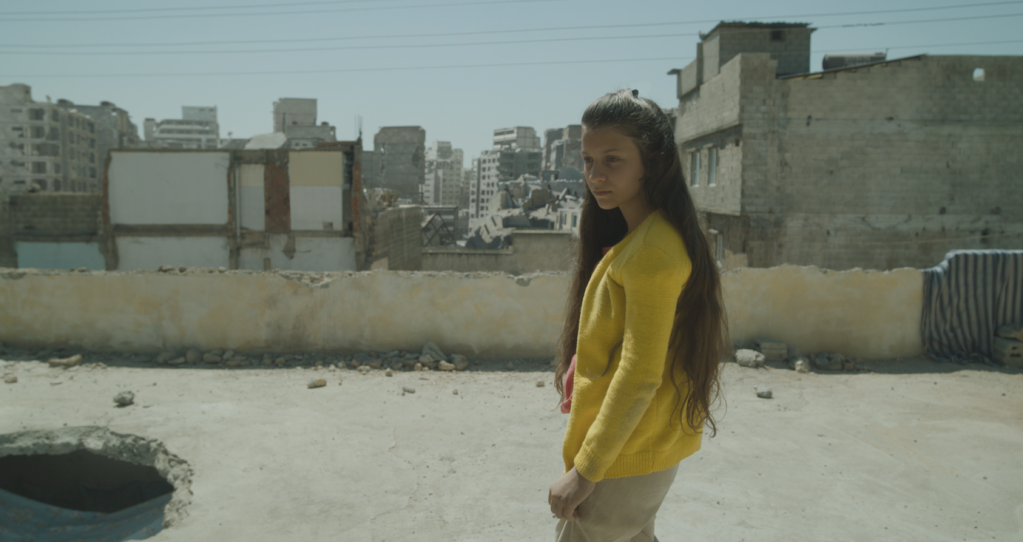
When studying cinema, we so often discuss the work from the point-of-view of the director, writer, or the actors on screen. French artist Hélène Louvart has been the cinematographer on many excellent pictures for over thirty years, with modern examples including The Lost Daughter, Never Rarely Sometimes Always and La Chimera. Her new film Nezouh is a beautifully told magical-realism drama, and it is written and directed by Soudade Kaadan. The Syria-based story centres around a young girl called Zeina (Hala Zein) who must decide whether or not to flee her hometown after a bomb attack almost completely destroys their house. I was lucky enough to sit down with Hélène to discuss this piece as well as her craft in general.
Nezouh takes a very different look at the Syrian war-torn landscape as the story is told through the perspective of young Zeina. How did you approach illustrating this in the style of the film?
You know, it was the point of view of the girl, but it’s a mix between her gaze and also the point of view, in the storytelling of course, from Soudade [Kaadan, the director]. We are not doing a documentary, but it is important to understand the context for the girl. If it was only her point of view perhaps it would be slightly too naive so it was a mix with Soudade as she knows exactly the situation. She left there, her parents are still there. For her it’s not a dream, it’s a reality but in the girl’s point of view she brought some magic moments.
These magic moments are prevalent in lots of films you have shot, with a recent example being Alice Rohrwacher’s La Chimera. Is this something that you bring to the table creatively or does it always come from the director’s vision?
It definitely comes from the director. I am here to help and I’m here to create something according to their wish. I can create something magic or I can create something realistic; it depends on what they want. For example, for Nezouh, Soudade wanted to tell the story but to bring in a magic world. Not an ideal world because it’s far from ideal but she wanted to bring hope into it and even if everything is destroyed, there is some hope. When the ceiling is destroyed, the sun comes through and when you have the sun it’s not so bad. It’s like visual poetry. From the perspective of Zeina, I wouldn’t say she is happy but suddenly her world is colourful.

You’ve worked with so many great directors and I suspect that some will be very specific in their brief with detailed storyboards and others will give you more freedom. How does this work in terms of the approach to collaboration around a film’s visual identity?
Sometimes people are very precise but at the same time, they know that it will be good to have my point of view to feel if it’s possible to do it. If they are too precise with a lot of shots, they want to do perhaps if they will have enough time. Some directors don’t like storyboards. I work with them on the shot list and perhaps change the storyboard and be able to adapt on the situation. When you have a storyboard, it’s great but the day you are shooting, it can become a disaster if you are late or the conditions aren’t how you thought they would be etc. You need somebody who can adapt the situation and I am here to try to understand what they want to do in each scene and to translate. The most important thing is when you arrive on set, it’s to know exactly what you want to shoot and this is linked with the script and linked with the mise-en-scène.
Do you like the precise way of working or is it nice to have the freedom to play around a bit more?
I think I prefer the free option but the most important thing is to be realistic because when you are shooting, you have to consider the crew, the time, the weather, the money, and you might have problems with everything. You might want to do it a certain way but in fact, cannot, so you would be sad all the time. If you are realistic, you are not surprised by your day and you can continue to be in the artistic world.
I’m interested in how you work with actors too as you’ve worked with huge names relatively recently such as Olivia Colman, Franz Rogowski, Josh O’Connor, and of course the stars of Nezouh. Does your job change a lot dependent upon who you are shooting?
I won’t name names but of course, I understand that when I shoot with the people who are acting very well, my work is slightly easier. It’s very important because in fact, if we trust the people who are acting, everything works. You don’t need to make so many shots, you don’t need to change your positioning of the camera. I like so much when the acting is great and I have to say it’s such a pleasure to film people who are acting well. At the same time, you can also shoot these people without any experience and it’s great also. It can be scary for them but you can grab some special moments.
I thought Hala Zein was brilliant in Nezouh and is obviously a very young actor. I know you shot Sarah Gavron’s coming-of-age film Rocks with a young, inexperienced cast so this must’ve been a similar experience?
Yes, they were totally, totally young but it was great. They did something very difficult with the performance. With Sarah, we were there to help and to give them the freedom!
NEZOUH is in UK & Irish cinemas 3rd May www.modernfilms.com/nezouh

